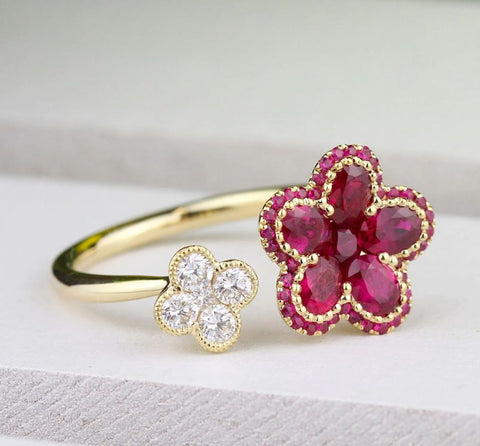Of all the red gemstones mined out of the earth, ruby is one of the most highly prized and sought after. It is the color of our most intense emotions - love and anger, passion and fury. Bible verses associated them with attributes like beauty and wisdom. Ruby, especially when untreated, can command the highest per-carat price of all colored stones. So what should you look for when shopping for this valuable gem?
What is ruby?
The name of the gemstone comes from the Latin rubinus, meaning red. Ruby is a variety of the mineral corundum, more specifically aluminum oxide. In it’s purest form, corundum is colorless. It’s color variations are caused by trace elements. In the case of ruby, its red hues are caused by chromium.
Did you know? Ruby ranks at 9 on the Moh’s scale, which rates a gemstones hardness. Diamonds are the hardest at 10. This makes natural rubies a wonderful candidate for fine jewelry and engagement rings.
Where are rubies mined?
According to legend, rubies originated in the Mogok valley of Burma, known today as Myanmar. The most renowned rubies, like those from Myanmar, Afghanistan and Vietnam are typically formed in marble deposits. Other sources include Mozambique, Madagascar, Malawi & Kenya. Thailand is the world’s largest ruby cutting center, followed by China, Sri Lanka and India.
Are rubies treated?
Today, almost all rubies are heat-treated to develop or intensify a ruby’s color. Heat treatments can also improve clarity by making inclusions less visible. Other treatments include lead glass filling.
What occasions are symbolized by ruby?
-
Ruby is the July birthstone
-
Ruby is used to commemorate the 40th wedding anniversary
What color should I look for in ruby jewelry?
Color is the single most important factor in choosing a ruby. For it to be considered a ruby, red must be its dominant color. The finest ruby has a pure, vibrant red to slightly purplish red hue. Some expressions you might hear are “ruby red”, “pigeon blood” and “blood red” used to describe the red color of a red ruby gemstone. If the dominant hue is pink, it may classified as a pink sapphire not ruby. Color is king!
Are all rubies GIA certified?
Large rubies of exceptional quality is one of the precious gemstones that a jeweler may send to GIA to be certified by a gemologist. That being said, even many high quality rubies do no necessarily have GIA certification. If you are purchasing a very large ruby and it’s important to you to have a certificate, allow several weeks and a hundreds of dollars to send the loose ruby in to GIA (shipping and insurance costs will also have to be considered).
Some beautiful ruby jewelry
This ruby eternity band from Tacori is positively divine. The rubies are deep, intense in color & saturation. Over 5 carats of rubies have been meticulously and perfectly matched in this gorgeous ruby ring.
This ruby wrap bracelet is a fun, whimsical way to wear rubies! We are simply in love with this design.
Birks Rosee du Matin collection has this simple necklace and matching earrings set into warm rose gold.
This unique ruby ring is from Parade Designs out of California. Large rubies & smaller rubies come together in a floral arrangement, accented by yellow gold. Negative space is brought together by another diamond flower.
In Summary:
Ruby is a unique and favored gemstone, not to be confused with star ruby or spinel. A gorgeous blood red ruby can make the heart of the wearer go pitty-pat due to its intense color and stunning red hue. Why not explore ruby as the next precious gem to add to your jewelry collection?
With Love, Perrara
Author: Lisa Maloney, Proprietor








